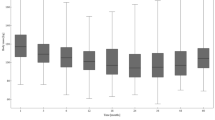A group of 300 consecutive morbidly obese patients who underwent a gastric banding procedure (gastric segmentation) by a single surgeon (F.G.W.) has been analysed as to their sex, age, hospitalization, complications and sequelae, reversal or reoperation, and weight loss. The time frame was from August 1984 to January 1991. Eighty-eight per cent were females and the average age was 37 years. The operative mortality was zero, and the complications were minor (1%). Eight women have had one or more normal pregnancies after the operation. Thirty-eight cases (12.7%) have had a reversal or a reoperation. Thirty-one patients (10.3%) were lost to follow-up. 271 cases have been operated on for more than 1 year and up to 6½ years. In those patients not lost to follow-up or who have not had a reoperation, 109 or 54% had a weight loss of 30% or more and 140 or 68% had a weight loss of 25% or more. We conclude that in our setting, the gastric banding is successful in promoting weight loss with a minimum risk and an acceptable reoperation or reversal rate.
Similar content being viewed by others
Author information
Authors and Affiliations
Rights and permissions
About this article
Cite this article
Westgate, F.G., Birmingham, C.L. Gastric Banding for Morbid Obesity: the St Paul's experience. OBES SURG 1, 287–291 (1991). https://doi.org/10.1381/096089291765561015
Published:
Issue Date:
DOI: https://doi.org/10.1381/096089291765561015




